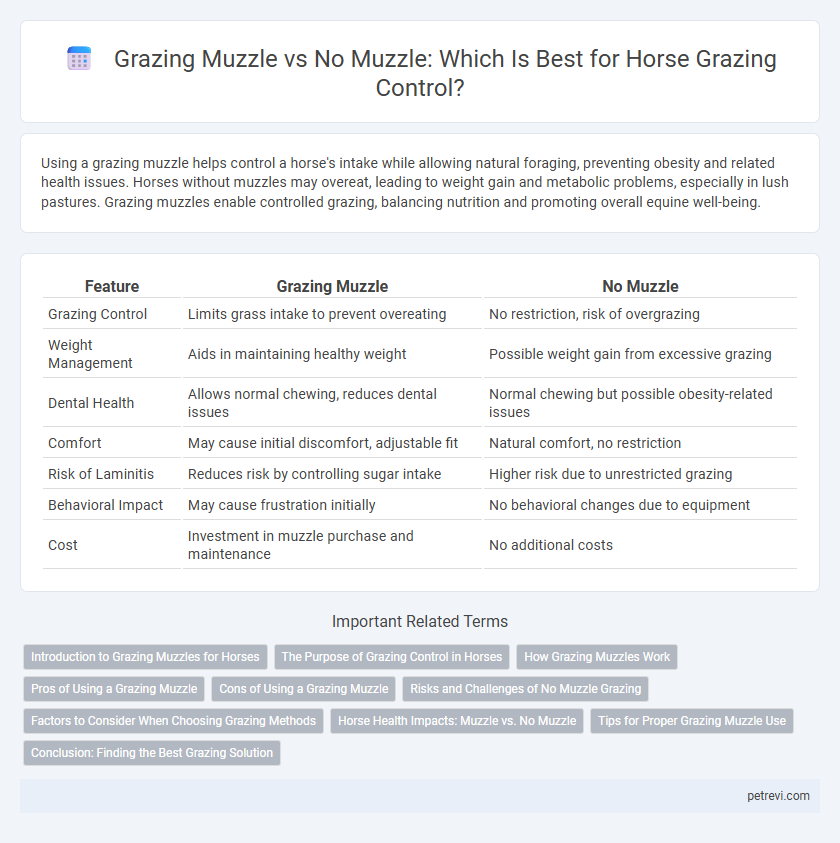Using a grazing muzzle helps control a horse's intake while allowing natural foraging, preventing obesity and related health issues. Horses without muzzles may overeat, leading to weight gain and metabolic problems, especially in lush pastures. Grazing muzzles enable controlled grazing, balancing nutrition and promoting overall equine well-being.
Table of Comparison
| Feature | Grazing Muzzle | No Muzzle |
|---|---|---|
| Grazing Control | Limits grass intake to prevent overeating | No restriction, risk of overgrazing |
| Weight Management | Aids in maintaining healthy weight | Possible weight gain from excessive grazing |
| Dental Health | Allows normal chewing, reduces dental issues | Normal chewing but possible obesity-related issues |
| Comfort | May cause initial discomfort, adjustable fit | Natural comfort, no restriction |
| Risk of Laminitis | Reduces risk by controlling sugar intake | Higher risk due to unrestricted grazing |
| Behavioral Impact | May cause frustration initially | No behavioral changes due to equipment |
| Cost | Investment in muzzle purchase and maintenance | No additional costs |
Introduction to Grazing Muzzles for Horses
Grazing muzzles regulate a horse's forage intake by limiting the amount of grass consumed while allowing normal eating and drinking behaviors. Horses without muzzles may overgraze, leading to weight gain and metabolic issues such as laminitis. Grazing muzzles provide an effective management tool to control calorie intake and maintain equine health during turnout.
The Purpose of Grazing Control in Horses
Grazing control in horses aims to prevent excessive grass intake that can lead to health issues like laminitis and obesity. Grazing muzzles reduce forage consumption by limiting the horse's ability to grasp and chew grass without completely restricting access to pasture. This controlled intake helps maintain optimal weight and metabolic health while allowing horses to engage in natural grazing behaviors.
How Grazing Muzzles Work
Grazing muzzles control a horse's grass consumption by limiting the amount of forage intake while allowing normal breathing and drinking. The small openings on a grazing muzzle reduce the horse's ability to consume large quantities of grass, effectively lowering calorie intake and preventing obesity and laminitis. Designed with adjustable straps, these muzzles ensure a secure fit without causing discomfort or restricting natural behavior.
Pros of Using a Grazing Muzzle
Using a grazing muzzle effectively limits a horse's grass intake, preventing obesity and metabolic disorders such as laminitis while still allowing natural foraging behavior. The muzzle promotes weight management without compromising the horse's ability to exercise and socialize, supporting overall mental and physical health. Its adjustable design ensures comfort and durability, making it a practical tool for long-term grazing control in pasture environments.
Cons of Using a Grazing Muzzle
Using a grazing muzzle can restrict a horse's natural grazing behavior and reduce overall intake of essential nutrients, potentially leading to nutritional deficiencies if not managed properly. The muzzle may cause discomfort, irritation, or chafing around the horse's muzzle area, impacting its willingness to graze and overall well-being. Horses wearing muzzles may also experience increased stress or frustration, which can manifest in behavioral issues and negatively affect their mental health.
Risks and Challenges of No Muzzle Grazing
No muzzle grazing can lead to excessive grass intake, increasing the risk of obesity, laminitis, and digestive issues in horses. Without a grazing muzzle, horses may consume toxic plants or overgraze sensitive pasture areas, resulting in poor land health and potential poisoning. Managing uncontrolled grazing requires constant supervision to prevent health complications and preserve pasture quality.
Factors to Consider When Choosing Grazing Methods
When choosing between a grazing muzzle and no muzzle for horse grazing control, factors such as the horse's weight management needs, pasture quality, and behavioral tendencies are crucial. A grazing muzzle effectively limits forage intake, preventing obesity and laminitis, while allowing natural grazing behavior, whereas no muzzle requires careful pasture rotation and monitoring to avoid overgrazing and health issues. Horse owners should also consider the horse's comfort, muzzle fit, and adaptability to ensure effective grazing management and overall well-being.
Horse Health Impacts: Muzzle vs. No Muzzle
Using a grazing muzzle helps control a horse's grass intake, reducing the risk of obesity, laminitis, and metabolic disorders by limiting calorie consumption. In contrast, not using a muzzle increases the risk of overgrazing, which can lead to weight gain, digestive upset, and hoof problems. Properly fitted muzzles allow horses to graze while minimizing health risks associated with unrestricted pasture access.
Tips for Proper Grazing Muzzle Use
To ensure effective grazing muzzle use, select a properly fitted muzzle that allows the horse to drink and breathe easily while limiting grass intake. Regularly inspect the muzzle for wear and clean it to prevent skin irritation and infections. Gradually introduce the muzzle, monitoring the horse's behavior and adjusting the fit to promote comfort and prevent stress during grazing.
Conclusion: Finding the Best Grazing Solution
Selecting the optimal grazing solution for horses depends on balancing effective weight control with the animal's natural behavior and comfort. Grazing muzzles limit grass intake and prevent obesity while allowing horses to socialize and exercise, whereas no muzzles require vigilant pasture management to avoid overgrazing and health risks like laminitis. Considering factors such as the horse's temperament, pasture quality, and duration of turnout ensures the best approach to maintain equine health and pasture sustainability.
Grazing Muzzle vs No Muzzle for Horse Grazing Control Infographic

 petrevi.com
petrevi.com